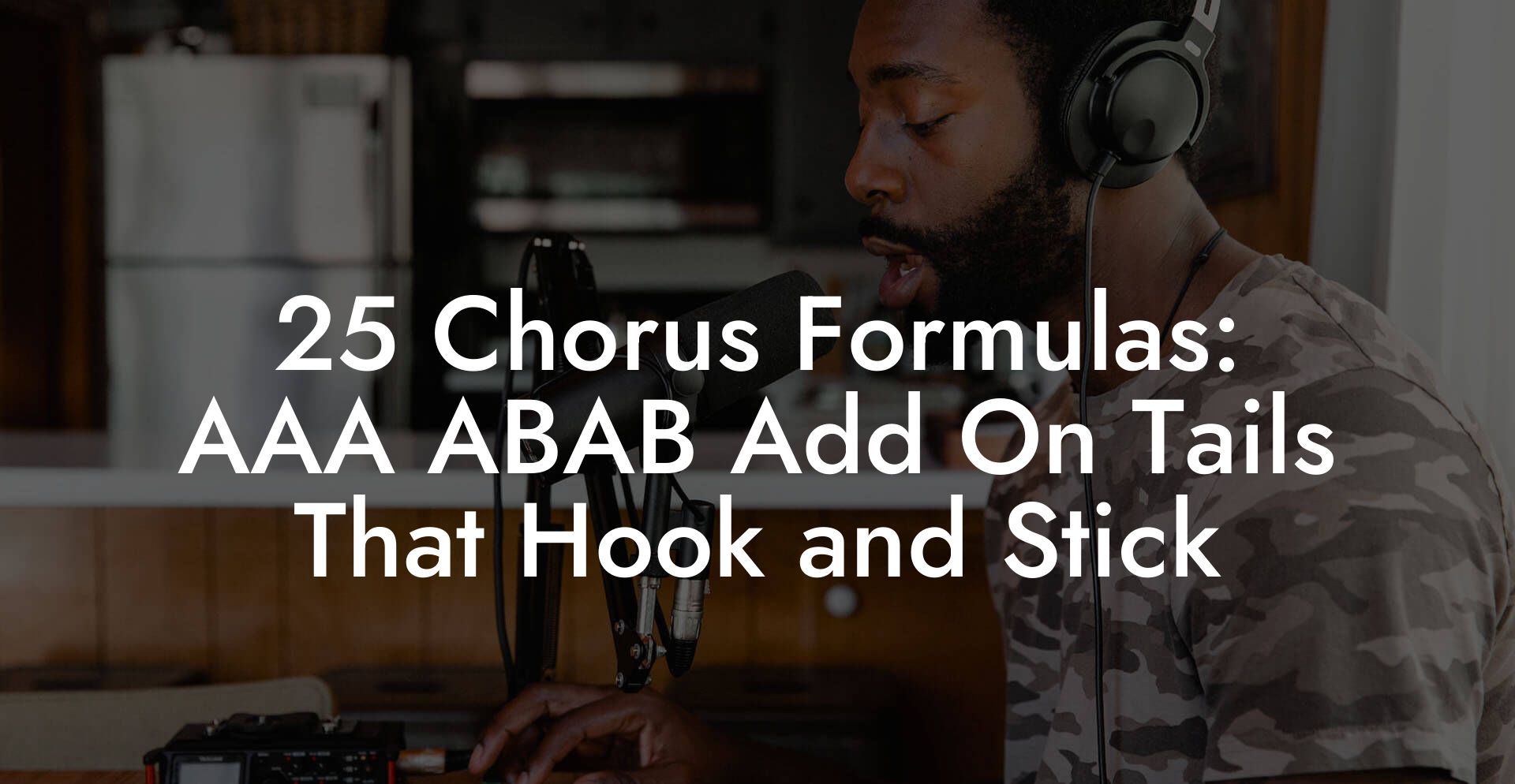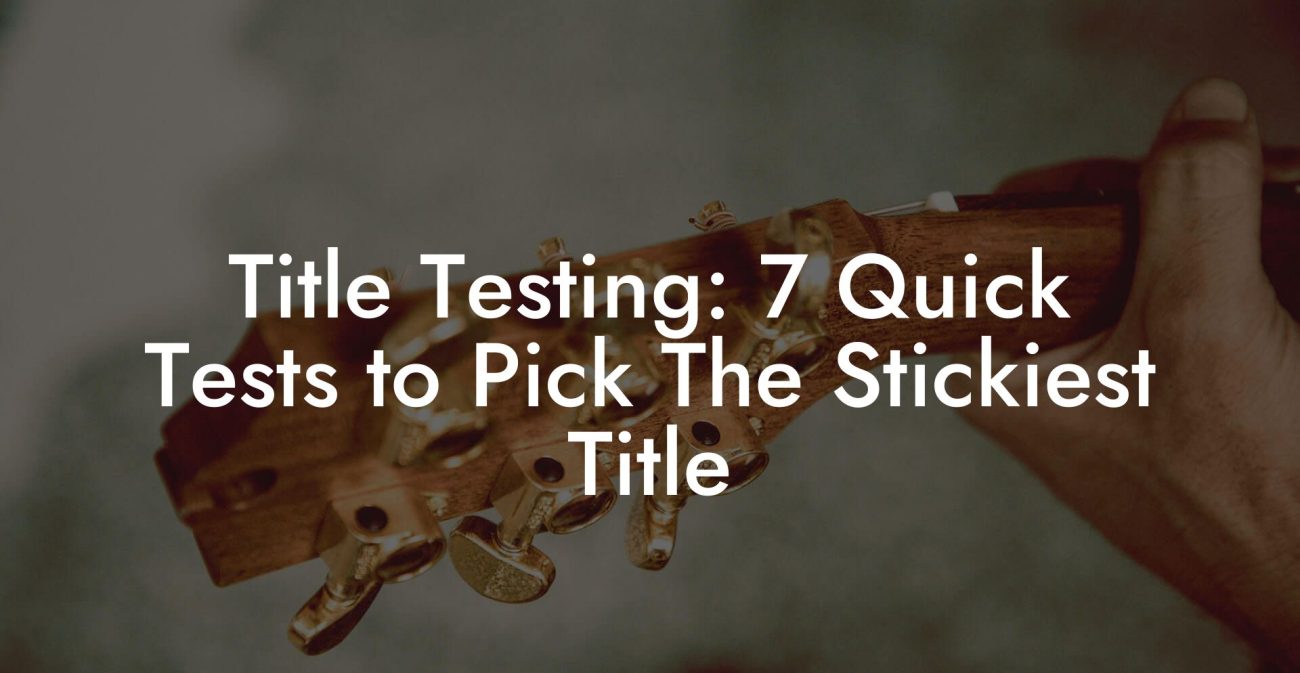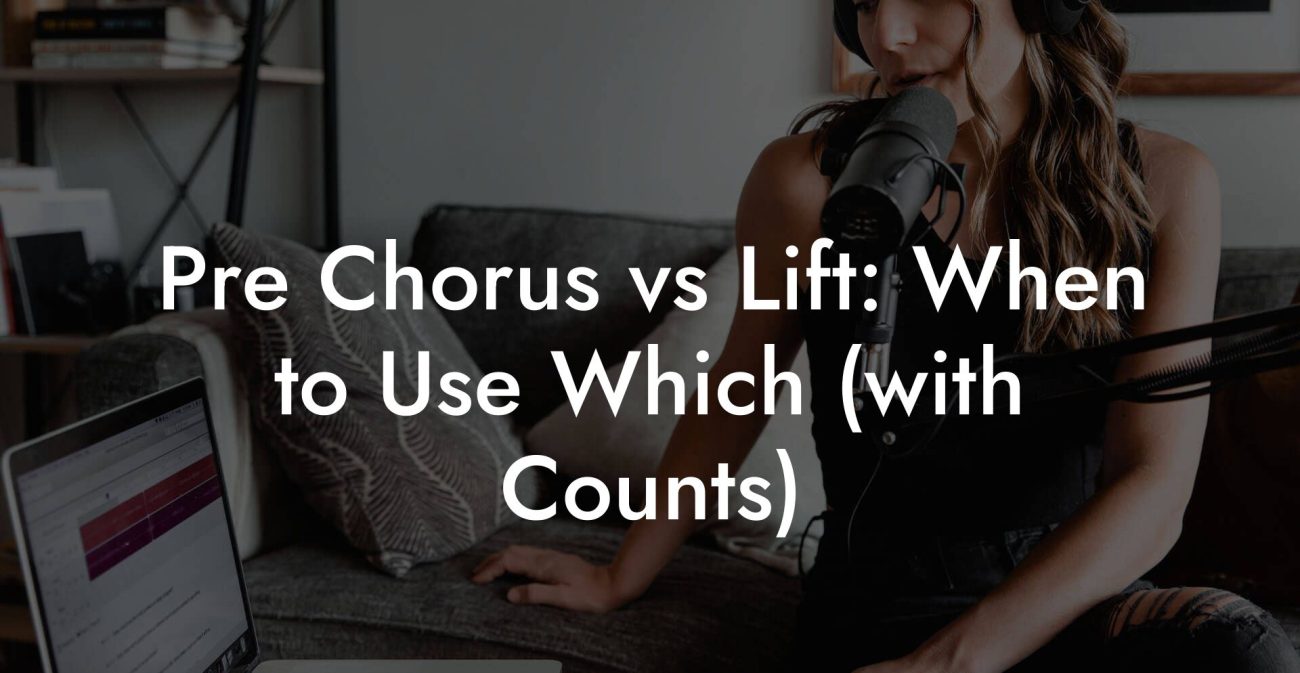Songwriting Advice
25 Chorus Formulas: AAA ABAB Add On Tails That Hook and Stick

You want a chorus that slaps, not one that sleeps on the couch of forgettability. You want listeners to hum your chorus on the bus, in the shower, and accidentally while they are doing taxes. This guide delivers 25 chorus formulas with real world examples, melodic notes, production tips, and scenarios that make each formula useful right now.
Quick Interruption: Ever wondered how huge artists end up fighting for their own songs? The answer is in the fine print. Learn the lines that protect you. Own your masters. Keep royalties. Keep playing shows without moving back in with Mom. Find out more →
Quick Links to Useful Sections
- What I Mean by Chorus Formula
- How to Use This Guide
- Why Chorus Formulas Matter
- Quick Prosody Reminder
- The 25 Chorus Formulas
- 1. AAA Straight Repeat
- 2. AAA with Escalation
- 3. AAA with Tail
- 4. ABAB Alternating Hook
- 5. ABAB with Call and Response
- 6. ABAB with Tag
- 7. Title Ring AAA
- 8. Anchored Chorus
- 9. Post Chorus Tag
- 10. Call and Answer AAA
- 11. ABAB with Harmonic Shift
- 12. The Crescendo Repeat
- 13. The Conversational Chorus
- 14. The Two Bar Hook
- 15. The Climactic Switch
- 16. The Echo Tag
- 17. The Micro Story Chorus
- 18. The Rhythm Shift Chorus
- 19. The Antiphon
- 20. The Minimal Anchor
- 21. The Contrast Chorus
- 22. The Machine Loop Chorus
- 23. The Surprise Change Up
- 24. The Rhyme Ladder
- 25. The Title Drop Switch
- How to Choose the Right Formula
- Practical Writing Drill
- Prosody Check List
- Production Shortcuts for Each Formula
- Real Life Scenarios
- Common Mistakes and Easy Fixes
- Examples You Can Model Right Now
- Action Plan You Can Use Today
- Key Terms Explained
- Chorus Testing Checklist
- Pop Quiz for Writers
- Frequently Asked Questions
This is for artists who write fast, for writers who overthink, for producers who want the topline to do the heavy lifting, and for every human who once cried into a playlist and then texted a lyric to a friend. We explain terms and acronyms so nothing reads like a secret ritual. You will leave with templates you can steal, twist, and make yours in one writing session.
What I Mean by Chorus Formula
A chorus formula is a reliable structural pattern for the chorus. Think of it as a template for how lines relate to each other melodically and lyrically. These formulas focus on repetition, variation, call and response, and tails that add payoff after the main hook. They work across pop, rock, hip hop, r b, electronic, and country.
We will use two shorthand labels a lot. AAA means the chorus is built from three iterations of the same melodic and lyrical idea with small changes. ABAB means the chorus alternates between two distinct phrases or melodic cells. Add on tails are short phrases that come after the main chorus to extend the earworm. Whenever we use an acronym or technical term we explain it immediately so you are never left guessing.
How to Use This Guide
Pick a formula. Draft a chorus using the short recipe we give. Record a quick demo using voice memo or your phone. Play it for one friend who does not overanalyze music. If they sing any line back, you win. Then iterate. The real value is in shipping and repeating what works quickly.
Why Chorus Formulas Matter
- Memory. People remember shapes more easily than sentences. Formulas give a shape.
- Speed. When you are stuck, a template gets you out of the abyss faster.
- Consistency. Your catalog will have identity if you use strong chorus habits.
- Performance. Live, you need a chorus that the audience can own on first listen.
Quick Prosody Reminder
Prosody refers to how words sit on rhythm and melody. Speak your lyric out loud at normal speed. Mark the stressed syllables. Those stresses should land on strong beats or long notes. If they do not you will feel friction even if the line looks clever. Fix prosody before you fix rhyme.
The 25 Chorus Formulas
Below are twenty five practical formulas. Each entry includes a short definition, a lyric micro example, melody advice, production tip, and a quick use case. Use the micro examples as seeds and not finished lyrics. Replace details with something personal for maximum effect.
1. AAA Straight Repeat
Definition: Three lines that repeat the same phrase or sentence with identical melody and only tiny lyric changes or punctuation. This is the pure earworm formula.
Example lyric: I will stay tonight. I will stay tonight. I will stay tonight.
Melody tip: Keep range narrow for instant singability. Small interval motion helps people join in quickly.
Production tip: Layer doubles on the second and third repeats to increase energy without changing the hook.
Use case: An intimate R B ballad or indie anthem where mantra style repetition sells commitment.
2. AAA with Escalation
Definition: Same melody repeated three times but each repeat adds new detail or intensity.
Example lyric: I will stay tonight. I will hold the light tonight. I will set the world alight tonight.
Melody tip: Keep the first repeat simple. Add a small harmony or lift on the third repeat to sell the escalation.
Production tip: Add one instrument with each repeat. A simple piano then added strings then subtle percussion keeps momentum.
Use case: Pop chorus that needs to build toward the drop without changing the main hook.
3. AAA with Tail
Definition: Repeat the main line three times then add a short tail phrase as payoff.
Example lyric: Leave me on the floor. Leave me on the floor. Leave me on the floor. I am fine I swear.
Melody tip: The tail sits slightly lower or higher to make it feel like a release.
Production tip: Automate a reverb swell into the tail to create space for the line to breathe.
Use case: Songs that want a classical mantra then a confessional afterthought.
4. ABAB Alternating Hook
Definition: Two distinct lines alternate. Each has a different melody and emotional role.
Example lyric: You are the reason I run. You are the map that gets me home.
Melody tip: Make one phrase short and punchy and the other longer and legato. Contrast is the engine.
Production tip: Pan one melodic element left and the other right for stereo drama.
Use case: Indie pop and alternative rock that likes vocal interplay.
5. ABAB with Call and Response
Definition: Line A is a lead phrase. Line B answers. The answer can be sung by backup vocals or a synth motif.
Example lyric: A You left without saying why. B I left because I had to try.
Melody tip: Keep the response rhythmically distinct so the ear recognizes the conversation.
Production tip: Use a different texture for the response. If the lead is dry vocal the response can be a doubled, effected voice.
Use case: R B and hip hop influenced tracks that like interplay between lead and crew.
6. ABAB with Tag
Definition: Alternate two phrases then end the chorus with a short repeated tag that serves as an earworm.
Example lyric: A Hold me like tomorrow is ours. B Hold me like we stole the stars. Tag Hold me hold me.
Melody tip: Make the tag extremely simple. One pitch or two notes works best.
Production tip: Sidechain the tag to the kick for a dance friendly pump.
Use case: EDM and pop crossovers that need a chantable end to the chorus.
7. Title Ring AAA
Definition: Put the title at the start and end of each repeat so the chorus forms a ring phrase that frames itself.
Example lyric: Come over. I will wait. Come over. I will wait. Come over. I will wait.
Melody tip: The title should land on a memorable interval each time.
Production tip: Add a tiny flange or chorus on the final title for a memorable sonic signature.
Use case: Radio pop songs that need a title to stick fast for playlisting.
8. Anchored Chorus
Definition: Repeat a short anchor line between longer lines. The anchor is the chorus spine.
Example lyric: Anchor I am fine. Long I built a house from the notes you left in my jean pockets. Anchor I am fine.
Melody tip: Anchor line should live center of range and be easy to sing numbingly.
Production tip: Keep the anchor dry in the mix and make the longer lines lush for contrast.
Use case: Story songs where you want a refrain that listeners can sing while your verses tell the story.
9. Post Chorus Tag
Definition: Full chorus then a short post chorus hook that repeats one motif or phrase. Post chorus means the hook sits after the main chorus rather than being part of it.
Example lyric: Chorus Then post chorus All night all night all night.
Melody tip: Post chorus should be the simplest melodic idea in the song to maximize mimicability.
Production tip: Use a chopped vocal or instrumental hook for the post chorus to make it ear candy.
Use case: Dance music and modern pop where you want a second earworm to lift the chorus.
10. Call and Answer AAA
Definition: The same melodic phrase repeats three times but the second or third repeat includes a short answer line that replies to the main phrase.
Example lyric: I keep the lights on. I keep the lights on. I keep the lights on when the phone rings soft.
Melody tip: Keep the call consistent. Make the answer rhythmically denser.
Production tip: Use call raw and unprocessed and the answer heavily treated so it feels like a response from the room.
Use case: Confessional tracks that need the chorus to mimic inner conversation.
11. ABAB with Harmonic Shift
Definition: Two alternating lines that sit over different chords. The shift gives the chorus a sense of movement without changing lyrics.
Example lyric: A I miss the backseat laughter. B I miss the tiny threats of midnight.
Melody tip: Align the melody to the chord tone change so the ear feels the harmony move.
Production tip: Bass movement can emphasize the harmonic shift while other instruments hold steady.
Use case: Singer songwriter and alternative tracks that want subtle emotional change.
12. The Crescendo Repeat
Definition: Repeat the same hook phrase but increase intensity each repeat by vocal delivery and arrangement.
Example lyric: Kiss me. Kiss me now. Kiss me like fire.
Melody tip: Keep the melodic content similar. Increase vocal power and use wider intervals later.
Production tip: Add harmonic layers with each repeat. Start minimal and expand to a choir feel on the last one.
Use case: Big arena pop or gospel influenced songs that need catharsis.
13. The Conversational Chorus
Definition: The chorus reads like a short dialogue. It alternates lines that feel like quotes from two people or two feelings.
Example lyric: You I will try. Me I have tried too long.
Melody tip: Give each voice a contrasting vocal tone. One voice could be breathy, the other bright.
Production tip: Pan voices slightly apart. Add textural differences to help the listener follow who is speaking.
Use case: Country duets and indie pop with a narrative angle.
14. The Two Bar Hook
Definition: Very short melodic phrase repeated across the chorus with lyric variation. Think of a slogan that shows new faces each time.
Example lyric: Two bars Coffee, cigarette. Two bars Late train, no regret. Two bars
Melody tip: Keep melody staccato and rhythmic. The hook thrives on groove not sustained notes.
Production tip: Tight percussion and a pulsing synth will give the hook forward motion.
Use case: Hip hop and alt R B where rhythm drives the ear.
15. The Climactic Switch
Definition: Chorus starts with one idea and switches for the final repeat to a more direct, lifted line that contains the title.
Example lyric: First two repeats I keep my coat on. Final repeat I keep my coat on and walk away with your name in my mouth.
Melody tip: Raise the range for the final repeat and hold the title on a long note.
Production tip: Create a moment of silence or drum drop before the final repeat to maximize impact.
Use case: Breakup songs that need a moment of decision or angry pop bops that end in release.
16. The Echo Tag
Definition: Main chorus then a spaced echo of one word or small phrase repeated like a bouncing thought.
Example lyric: Chorus Then echo Love love love.
Melody tip: Use descending pitches for the echoes so they feel like fading memory.
Production tip: Automate decay on the echo so it gets shorter each time.
Use case: Dreamy pop and atmospheric tracks that enjoy space.
17. The Micro Story Chorus
Definition: Each chorus repeat tells the next line of a small story. The hook connects the parts so the chorus reads as a mini narrative.
Example lyric: I found the letter. I read your handwriting. I burned the paper in the sink.
Melody tip: Keep the anchor line similar across repeats so the story stays anchored to a hook.
Production tip: Use a repeating motif to tie the three lines together sonically even as the words change.
Use case: Folk and singer songwriter material that wants a chorus with arc.
18. The Rhythm Shift Chorus
Definition: The chorus repeats the same lyric but with different rhythmic phrasing each time. This keeps the ear guessing while the words stay the same.
Example lyric: Stay with me. Stay with me. Stay with me.
Melody tip: Change the placement of stresses and add syncopation on a later repeat.
Production tip: Alter percussion pattern subtly with each repeat to reinforce the rhythm change.
Use case: R B and neo soul where groove is central.
19. The Antiphon
Definition: A short chorus sung by the lead followed by a stacked choir or crowd response. The chorus works as a communal answer.
Example lyric: Lead Come home. Crowd Come home come home come home.
Melody tip: Keep the crowd answer simple so a real crowd can sing it back live.
Production tip: Use layered vocal stacks with different timbres to create the crowd feel.
Use case: Arena pop and gospel influenced tracks.
20. The Minimal Anchor
Definition: Chorus is one repeated short line with heavy instrumental interest. The lyric is tiny and the music carries the color.
Example lyric: I am okay. I am okay. I am okay.
Melody tip: Use a narrow range and let production deliver the drama.
Production tip: Use changing textures to provide interest rather than lyrical variety.
Use case: Electronic and alternative artists who favor mood over words.
21. The Contrast Chorus
Definition: Chorus words are opposite in tone to the verse. If the verse is bleak the chorus lands bright. This formula uses contrast for emotional payoff.
Example lyric: Verse describes rain. Chorus I feel sunlight in my bones.
Melody tip: Open the vowels in the chorus and move to a higher range for warmth.
Production tip: Use brighter instrument timbres for the chorus to enhance the contrast.
Use case: Pop songs that trade darkness for optimism.
22. The Machine Loop Chorus
Definition: A short lyric repeated over a looping instrumental motif that evolves. The chorus is hypnotic rather than narrative.
Example lyric: We are electric. We are electric. We are electric.
Melody tip: Keep melody tight and rhythmic so it locks with the loop.
Production tip: Progress the loop gradually. Add a new element every two repeats to keep it interesting.
Use case: Dance and electronic tracks that aim for a trance like effect.
23. The Surprise Change Up
Definition: Chorus repeats normally then a surprise melodic or lyrical shift occurs mid chorus that redefines the hook.
Example lyric: First two repeats I will call you later. Third repeat I will call the police instead.
Melody tip: Put the surprise on an unexpected interval so it lands like a cinematic reveal.
Production tip: Drop instruments out for one bar before the surprise so the ear pays attention.
Use case: Comedy songs, storytelling songs, and tracks that favor twist above repetition.
24. The Rhyme Ladder
Definition: Chorus lines end with words that create an ascending chain of rhyme families. This keeps interest while using repetition.
Example lyric: Late, wait, fate, remake.
Melody tip: Use the same melodic ending for each line so the rhyme ladder feels like a ladder you climb.
Production tip: Add subtle countermelodies to highlight the rhyme progression.
Use case: Pop and country lyricists who like clever wordplay without losing singability.
25. The Title Drop Switch
Definition: The chorus avoids the title in early repeats and then drops the title in the last repeat as a payoff. This creates anticipation.
Example lyric: First repeats without title. Last repeat I say the name I kept inside for months. Title My name is freedom.
Melody tip: Make the title landing broad and singable. It should feel like the chorus finally arrived.
Production tip: Build tension using arrangement and release it on the title with a full band hit.
Use case: Songs that want a strong payoff and a memorable title moment for radio and playlists.
How to Choose the Right Formula
Pick the formula that answers three questions
- How quickly do I want the listener to know the hook
- Do I want repetition or a narrative arc
- Will this chorus be a live chant or a studio intimacy moment
If you want instant singability choose short repeated formulas like AAA Straight Repeat or Post Chorus Tag. If you want story choose Micro Story Chorus or Minimal Anchor. If you need arena impact choose Crescendo Repeat or Antiphon.
Practical Writing Drill
Pick one formula. Set a timer for fifteen minutes. Draft three chorus variants using the same title. For each variant change only one thing from the last try. The goal is quick iteration. After three passes pick the one that makes your chest tighten or makes your friend sing the line back. That is the one you keep.
Prosody Check List
- Read the chorus aloud at conversation speed
- Mark the natural stress syllables
- Ensure stressed syllables land on strong beats
- Keep vowels singable on long notes
- If it feels awkward rewrite the line for the mouth first and mind second
Production Shortcuts for Each Formula
Use these production quick wins to make any chorus hit harder
- Layer a double vocal on the second repeat
- Introduce one new instrument on each repeat to escalate
- Automate reverb sends to increase space on tails and echoes
- Use a quick riser or white noise sweep before a title drop to focus attention
- Mute a core element for one bar to make the return more satisfying
Real Life Scenarios
Scenario one You are writing a breakup song that needs a mantra to help listeners feel less alone. Use AAA with Escalation. Keep the title short. On the third repeat add a detailed image that makes the line feel lived in.
Scenario two You produce a club banger and need a chant that DJs can loop. Use Post Chorus Tag with a two bar hook. Make the tag drum friendly and rhythmically obvious. Think about crowd response when you place breaths and spaces.
Scenario three You co write with someone who brings great lines but no title. Use Title Ring AAA. Turn their best line into the ring phrase and scaffold around it with verses that supply context and pre chorus tension.
Common Mistakes and Easy Fixes
- Too many ideas in one chorus. Fix by committing to one emotional promise per chorus.
- Title hidden. Fix by placing title on a strong beat with open vowel sound.
- Prosody mismatch. Fix by speaking the line and moving stressed syllables to beats.
- No contrast. Fix by changing melody range, texture, or rhythm between verse and chorus.
- Over produced chorus. Fix by stripping ingredients to find the hook before you add toys.
Examples You Can Model Right Now
Template practice pick any of the formulas above. Replace generic details with your life. Real names, objects, and small actions make choruses vivid.
Example for Title Drop Switch with personal detail
First repeats I pack the drawer with letters I never send. Second repeat I fold them like paper boats. Final repeat I spit the name out like a river. Title You said Maria like a secret I could not keep.
Example for Two Bar Hook in a dance setting
Two bars Beat drops, city glows. Two bars Heart knocks, everybody knows.
Action Plan You Can Use Today
- Choose three formulas from this list that feel close to your current project
- For each formula craft a one sentence chorus seed and record a raw vocal on your phone
- Play the recordings for one friend who is not your mom. If they sing a line back you have something to work with
- Pick the strongest of the three and write a verse that sets up the chorus promise directly
- Demo with a simple arrangement and test the chorus in headphones and on a small speaker
Key Terms Explained
AAA This label means the chorus repeats the same melodic cell across three lines. Each repeat can include small changes but the core is identical.
ABAB This means two different melodic or lyrical cells alternate throughout the chorus. The A cell and the B cell each serve different emotional or rhythmic purposes.
Post chorus A short hook that follows the main chorus, often simpler and designed to be a second earworm. This is common in modern pop and dance music.
Prosody How words fit the rhythmic and melodic structure of a song. Good prosody makes lyrics feel natural to sing.
Tag A repeated phrase that ends a chorus. Tags are often chantable and short so fans can remember them easily.
Chorus Testing Checklist
- Can someone hum it after one listen
- Does the title appear clearly and singably
- Are stressed syllables on strong beats
- Does the chorus contrast with the verse
- Does the chorus have one idea not three
Pop Quiz for Writers
Pick a chorus from your catalog. Ask these three questions
- Would this chorus still work with only voice and guitar
- Can a stranger sing the first line back immediately
- Does the chorus contain at least one concrete image or object
Answer yes to two out of three and you are likely sitting on something usable. Answer yes to all three and you might have a single that gets played at weddings and breakups in equal measure.
Frequently Asked Questions
Below are common questions about chorus formulas. FAQ stands for Frequently Asked Questions. We include short answers you can act on immediately.




